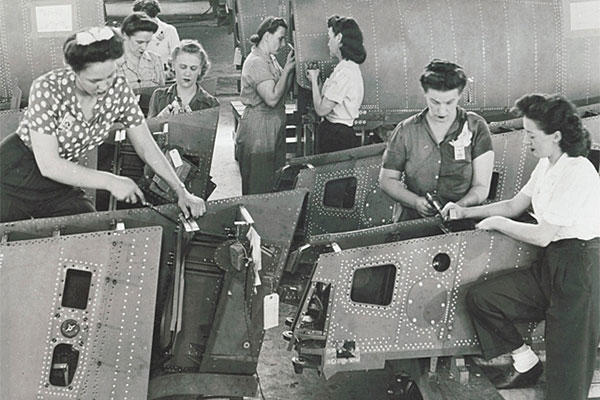In today's world, gender-segregated workplaces seem a quaint anachronism. A relic of a time in which the notion of "women's work" conjures images of domestic labor or the garment industry.
But the widespread acceptance of women in the American workforce is not ancient, nor was it inevitable.
For that, we owe a considerable debt of gratitude to a generation of women who answered their nation's call in WWII to join a labor force depleted by male enlistment -- the American Rosies.
These women -- personified in the iconic "We Can Do It!" poster of Rosie the Riveter -- made victory over Nazi Germany and Imperial Japan possible.
But they also irrevocably changed American assumptions about work and who was qualified to do it.
The phenomenon of women assuming traditionally male occupations was not some kind of deliberate gender-equity initiative. It was a simple imperative of all-out war.
When 6-8 million American women were pressed into service in armament and manufacturing industries, the only thing that mattered was whether they could do the job.
Mildred Crow Sargent was one of them, a teenage mother from Tennessee who migrated to Detroit in 1942 to work in an aircraft assembly plant as part of America's massive mobilization for WWII.
As she told a New York University "Real Rosie the Riveter" history project in 2010, she was "the fastest riveter" in the place. So fast that the plant overseers encouraged her to slow production down a bit.
Sargent said she replied, "Those soldiers (on the battlefield) can't slow production. If someone comes at them with a gun, they've got to shoot."
After that, she said, "They didn't bother me anymore."
Sargent's spirit was emblematic of the attitude of the American women who flooded the workplace in the 1940s to produce munitions and otherwise support the war effort. A spirit that was captured in song, promotional films and in the iconic bulging-bicep and red-polka-dot-bandana Rosie the Riveter poster.
This year, we are celebrating the contributions of those great patriots.
In a tribute placed in the congressional record on the first of this month, Women's History Month, I asked our fellow citizens to remember that America's Rosies "played an invaluable role in the war effort and victory. (Their) rigorous work and passionate love of our great country is arguably what sustained the American people, at home and abroad, during a volatile time of war and uncertainty."
Recently, dozens of "Original Rosies" flew (courtesy of the Talons Out Honor Flight, Ford Motor Co. Fund, and the Yankee Air Museum) from Detroit to Washington, D.C., where I, along with other members of Michigan's congressional delegation, welcomed them to the nation's Capitol and thanked them for their service and contribution to the war effort.
As the Arsenal of Democracy in WWII, Michigan's ties to the rise of the Rosies and the successful prosecution of the war are deep and lasting.
The woman most often cited as the embodiment of a real-life Rosie the Riveter was a young Kentucky native, Rose Will Monroe, who worked on the production of B-24s and B-49s at the Willow Run Bomber Plant in Ypsilanti.
The inspiration for the "We Can Do It!" poster was another Michigan factory worker, Geraldine Hoff Doyle, employed briefly by an Ann Arbor-area metal stamping plant, but long enough to be captured in a UPI photograph that became the model for America's most famous Rosie.
Monroe and Doyle have both since passed. But their stories, and the stories of the millions of American women who answered their country's call in WWII, will resonate for generations. Both for the contributions they made to preserving civilization, and for blazing a trail for millions of women that followed them into the workplace.
America's Rosies built the armaments that led the world to peace in the 1940s, and expanded the horizon of prosperity and self-determination for generations to come.
They were, and are, true American heroes.
-- Rep. Candice Miller is currently serving her seventh term after first being elected to office in November 2002. In addition to representing the views of Michigan's 10th Congressional District in the Halls of Congress, Miller serves as chairman of the Committee on House Administration, currently serving as the only woman chair of a committee in the U.S. House of Representatives. She serves as vice chair of the House Committee on Homeland Security, and is a member of the Committee on Transportation and Infrastructure. In Congress, Miller has been a leader in protecting the Great Lakes and promoting Michigan industry.




























